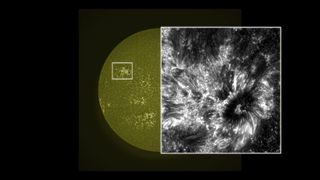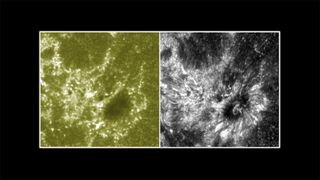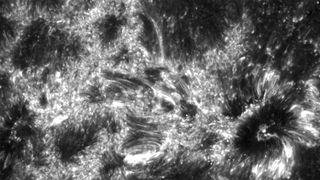NASA Spacecraft Sees Violent Solar Realm Beneath Sun's Surface (Photos, Video)
A writhing, violent region below the surface of the sun glows in a newly revealed video.
Scientists created the video (released on Feb. 6) using footage collected by NASA's Interface Region Imaging Spectrograph spacecraft (IRIS, for short). The probe is designed to peer below the sun's surface into the "interface region." You can watch a video of the new IRIS sun footage on SPACE.com.
"The spacecraft is designed to take high-resolution images of the interface region in unprecedented detail," NASA officials said in a statement announcing the video. "Such images will help scientists see how energy traveling through the region heats the sun's upper atmosphere to temperatures a thousand times hotter than the surface." [How NASA's IRIS Sun-watching Satellite Works (Infographic)]

By analyzing IRIS sun images, NASA scientists have found that the interface region of the sun is more violent than expected, and houses never-before-seen fine fiber-like structures, NASA officials said. Images of the sun used in the video were taken on June 27, 2013.
Studying solar activity may help scientists on Earth learn more about how to protect the planet from potentially harmful solar weather, NASA scientists have said. Powerful solar storms can threaten satellites in space and astronauts living and working above the International Space Station.

"Understanding how energy and solar material move through the interface region could help scientists improve forecasts for the kinds of events that can disrupt Earth technologies," NASA officials said in a 2013 IRIS announcement.
IRIS launched to space in June 2013. The sun-observing spacecraft orbits Earth and is part of NASA's Small Explorer program that caps mission costs at $120 million.
Sign up for the Live Science daily newsletter now
Get the world’s most fascinating discoveries delivered straight to your inbox.
The sun is currently in the peak of its 11-year solar cycle. Known as Solar Cycle 24, scientists have said that it is the quietest solar maximum in a century. The sun's quiescent solar maximum doesn't mean the star is completely quiet, however. The sun shot off a powerful X1.2-class solar flare about a month ago on Jan. 8.

The space agency also has a fleet of other sun-observing satellites in space now. Among them is the Solar Dynamics Observatory, which records high-definition images of the star's atmosphere. The Solar and Heliospheric Observatory — a project of both NASA and the European Space Agency — also monitors the sun's activity and has been operational for more than 15 years.
Follow Miriam Kramer @mirikramer and Google+. Follow us @Spacedotcom, Facebook and Google+. Original article on Space.com.












